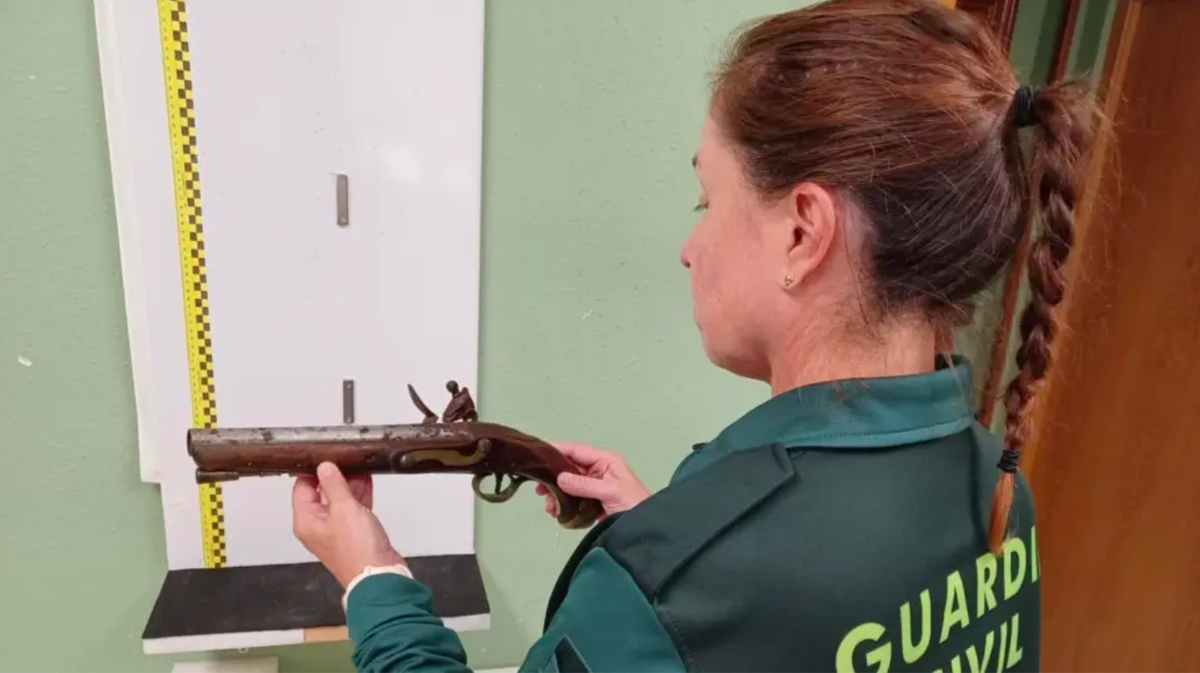British officials are reportedly assisting with tracing the pistol’s origin and determining how it came into private hands in Spain.
Photo credit: Guardia Civil
The Guardia Civil has opened an investigation into a woman from Miranda de Ebro (Burgos) for allegedly sending a historic firearm dating back to 1802 through the postal system. Authorities believe the weapon could have belonged to a British monarch, adding an unexpected royal twist to what initially appeared to be a standard parcel inspection.
According to police reports, the package was detected during a routine security check in the Spanish postal system. Agents from the Guardia Civil’s Weapons and Explosives Intervention Unit (IAE) in Burgos were immediately notified after the parcel appeared to contain a potentially dangerous object. Upon examination, officers discovered that the item inside was not only a weapon, but an antique firearm with significant historical value.
A Weapon Linked to a British Monarch
A 19th-Century Flintlock Pistol with Unique Craftsmanship
The firearm, a flintlock pistol manufactured in 1802, reportedly bears engravings and insignia that link it to the early 19th-century British royal family. Initial forensic analysis suggests the weapon may have belonged to a member of the House of Hanover, possibly King George III or one of his sons, though further investigation is required to verify its provenance.
Most Read on Euro Weekly News
Experts from Spain’s cultural heritage unit and the British embassy have been contacted to help authenticate the piece. The weapon’s ornate detailing, gold inlays, and maker’s marks are consistent with those found on presentation pistols gifted to British royalty and military officers during the Napoleonic era.
“This is not an ordinary firearm,” a Guardia Civil spokesperson said. “Its condition, craftsmanship, and historical associations make it a potential museum piece rather than a functional weapon.”
 The pistol is believed to have belonged to King George III or one of his sons
The pistol is believed to have belonged to King George III or one of his sons
Postal Discovery Triggers International Attention
Cross-Border Inquiry Between Spain and the UK
Once authorities confirmed the item’s potential royal connections, they alerted Interpol and the UK’s Metropolitan Police Art and Antiques Unit. British officials are reportedly assisting with tracing the pistol’s origin and determining how it came into private hands in Spain.
The woman under investigation, whose identity has not been disclosed, reportedly declared the item as an “antique decorative object” when she sent it by post. She told officers that she had inherited the pistol from a deceased relative and believed it to be of little value.
However, Spanish law strictly regulates the transport and sale of antique firearms. Even when the weapon is non-operational, shipping it without authorisation can constitute a serious offence.
Legal Implications Under Spanish and International Law
Potential Charges for Contraband and Arms Trafficking
Under Spain’s Arms Regulation (Real Decreto 137/1993), any antique firearm dating before 1870 must be declared and, in some cases, registered if transferred or exported. Sending such an item through regular post without appropriate documentation could be treated as a case of contrabando (smuggling or unauthorised arms transfer).
If found guilty, the woman could face heavy fines and even a criminal record. However, given the apparent lack of malicious intent and the cultural rather than commercial nature of the item, investigators are reportedly considering the case as a potential administrative offence rather than a criminal one.
Preserving Historical Heritage
Authorities Emphasise Cultural Responsibility
Beyond the legal dimension, the incident has reopened debate about private ownership of historical weapons and cultural artefacts. The Guardia Civil’s Heritage Protection unit highlighted the importance of reporting such items to the authorities or heritage institutions rather than attempting to sell or post them.
“This case shows the need for public awareness,” the Guardia Civil statement read. “Objects that may appear decorative could, in fact, be part of our shared history and deserve expert evaluation.”
The firearm is now being held at the Burgos provincial command while the investigation continues. If its royal provenance is confirmed, it may be transferred to a museum or returned to the UK as part of cultural cooperation between both countries.
Ongoing Investigation and Cultural Significance
From Postal Package to Historical Mystery
What began as a suspicious package at a postal sorting centre has turned into a remarkable historical mystery linking Spain and the United Kingdom. Forensic experts, historians, and international police agencies are now working together to uncover how an early 19th-century royal pistol ended up in northern Spain, and why it was sent through the post over 200 years later.
Authorities expect the final report within the coming weeks. In the meantime, the woman remains under investigation but has not been formally charged.
The case serves as a reminder that history often reappears in the most unexpected ways, sometimes even wrapped in brown paper and sealed with a postage stamp.
